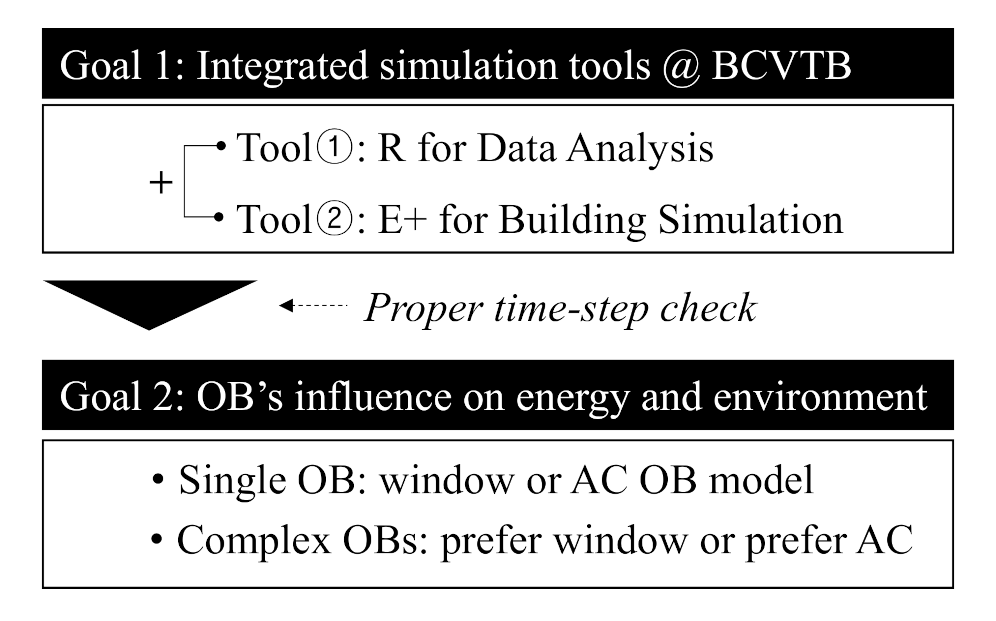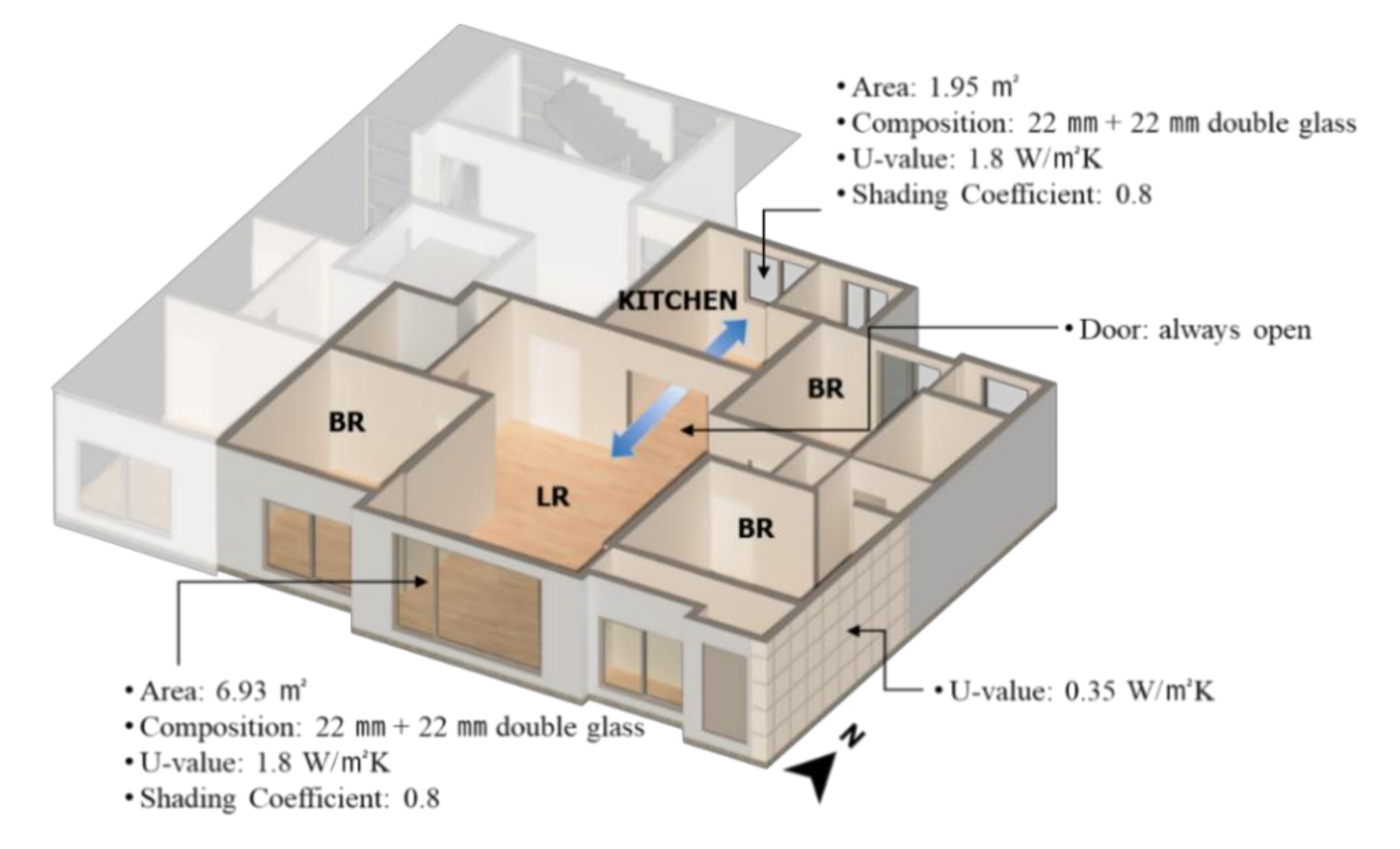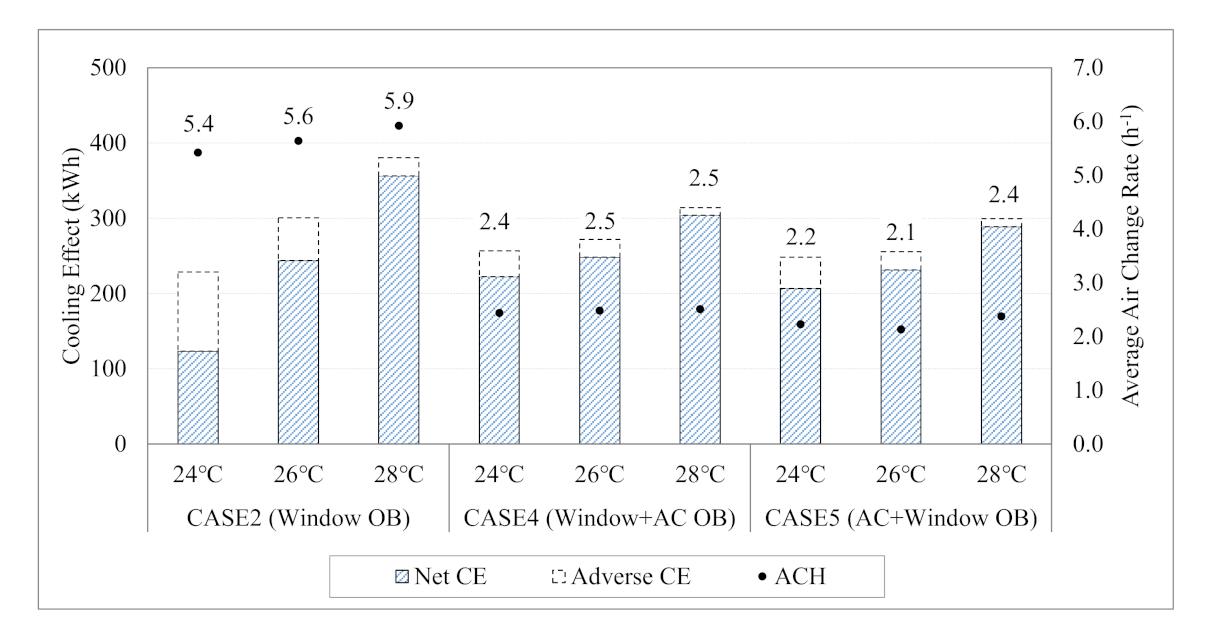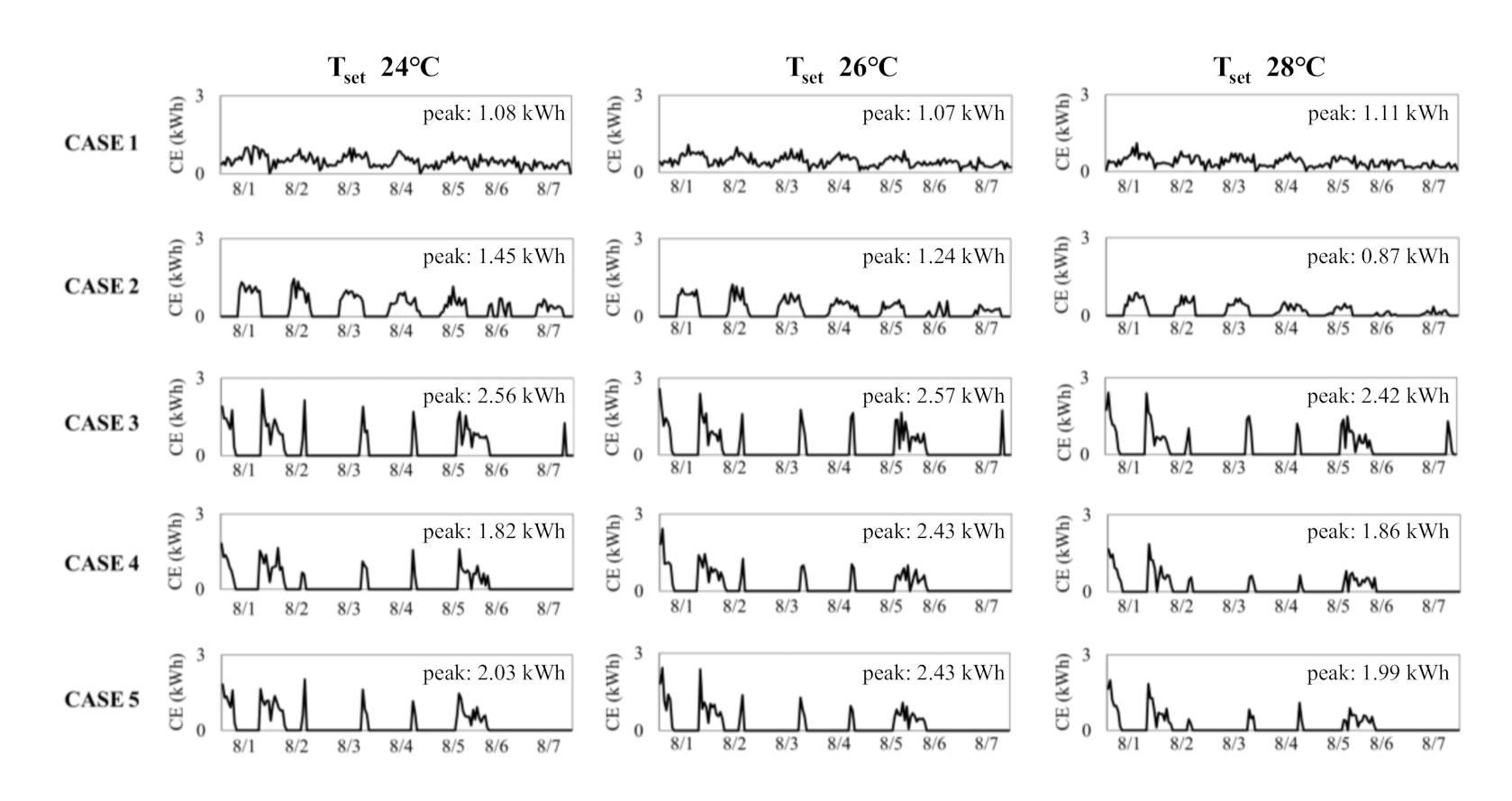Influence of Complex Occupant Behavior Models on Cooling Energy Usage Analysis
Abstract
:1. Introduction
2. Materials and Methods
2.1. Occupant Behavior (OB)
2.1.1. AC On/Off
2.1.2. Set Temperature Adjustment
2.1.3. Window Open/Closed State
2.2. Co-Simulation
3. Building Energy Simulation with OB
3.1. Overview of the Building Energy Simulation
3.2. Applying OB Models for Building Energy Simulation
3.2.1. Logit Model for Window State
3.2.2. RF Model for AC State
3.3. Definition of Cases
4. Results and Discussion
4.1. Effects of the Timestep on OB Simulation
4.2. OB Applicability
4.2.1. Window Operation
4.2.2. AC Usage
4.2.3. Cooling Energy Usage
5. Conclusions and Future Work
Author Contributions
Funding
Institutional Review Board Statement
Informed Consent Statement
Data Availability Statement
Conflicts of Interest
References
- KEEI. Analysis of Energy Consumption Expenditure by Household Characteristics; KEEI Occasional research report; KEEI: Ulsan, Korea, 2013. [Google Scholar]
- Ren, X.; Yan, D.; Wang, C. Air-conditioning usage conditional probability model for residential buildings. Build. Environ. 2014, 81, 172–182. [Google Scholar] [CrossRef]
- Zaki, S.A.; Hagishima, A.; Fukami, R.; Fadhilah, N. Development of a model for generating air-conditioner operation schedules in Malaysia. Build. Environ. 2017, 122, 354–362. [Google Scholar] [CrossRef]
- Tanimoto, J.; Hagishima, A. State transition probability for the Markov Model dealing with on/off cooling schedule in dwellings. Energy Build. 2005, 37, 181–187. [Google Scholar] [CrossRef]
- Yan, D.; O’Brien, W.; Hong, T.; Feng, X.; Burak Gunay, H.; Tahmasebi, F.; Mahdavi, A. Occupant behavior modeling for building performance simulation: Current state and future challenges. Energy Build. 2015, 107, 264–278. [Google Scholar] [CrossRef] [Green Version]
- Johnston, D.; Siddall, M.; Ottinger, O.; Peper, S.; Feist, W. Are the energy savings of the passive house standard reliable? A review of the as-built thermal and space heating performance of passive house dwellings from 1990 to 2018. Energy Effic. 2020, 13, 1605–1631. [Google Scholar] [CrossRef]
- Pisello, A.L.; Asdrubali, F. Human-based energy retrofits in residential buildings: A cost-effective alternative to traditional physical strategies. Appl. Energy. 2014, 133, 224–235. [Google Scholar] [CrossRef]
- Pisello, A.L.; Asdrubali, F.; Guerra-Santin, O.; Bosch, H.; Budde, P.; Konstantinou, T.; Boess, S.; Klein, T.; Silvester, S. Considering user profiles and occupants’ behaviour on a zero energy renovation strategy for multi-family housing in The Netherlands. Energy Effic. 2018, 11, 1847–1870. [Google Scholar] [CrossRef] [Green Version]
- Tuohy, P.G.; Murphy, G.B.; Devici, G. Lessons from post occupancy evaluation and monitoring of the 1st passive house in Scotland. In Proceedings of the Passivhus Norden Conference, Trondheim, Norway, 21–23 October 2012. [Google Scholar]
- Page, J.; Robinson, D.; Morel, N.; Scartezzini, J.L. A generalised stochastic model for the simulation of occupant presence. Energy Build. 2008, 40, 83–98. [Google Scholar] [CrossRef]
- Balvedi, B.F.; Ghisi, E.; Lamberts, R. A review of occupant behaviour in residential buildings. Energy Build. 2018, 174, 495–505. [Google Scholar] [CrossRef]
- Fabi, V.; Sugliano, M.; Andersen, R.K.; Corgnati, S.P. Validation of occupants’ behaviour models for indoor quality parameter and energy consumption prediction. Procedia Eng. 2015, 121, 1805–1811. [Google Scholar] [CrossRef] [Green Version]
- Fabi, V.; Andersen, R.K.; Corgnati, S. Verification of stochastic behavioural models of occupants’ interactions with windows in residential buildings. Build. Environ. 2015, 94, 371–383. [Google Scholar] [CrossRef]
- Andersen, R.K.; Fabi, V.; Corgnati, S.P. Predicted and actual indoor environmental quality: Verification of occupants’ behaviour models in residential buildings. Energy Build. 2016, 127, 105–115. [Google Scholar] [CrossRef] [Green Version]
- Schweiker, M.; Haldi, F.; Shukuya, M.; Robinson, D. Verification of stochastic models of window opening behaviour for residential buildings. J. Build. Perform. Simul. 2012, 5, 55–74. [Google Scholar] [CrossRef]
- Imagawa, H.; Rijal, H.B.; Shukuya, M. Development of single and combined fan-use models in Japanese dwellings. IOP conf. ser. Earth Environ. Sci. 2019, 294, 012078. [Google Scholar] [CrossRef]
- Imagawa, H.; Rijal, H.B.; Shukuya, M. Development of an integrated behavioural model on the control of window, heating and cooling in dwellings of Kanto region. J. Environ. Eng. 2019, 84, 855–864. [Google Scholar] [CrossRef]
- Yu, C.; Du, J.; Pan, W. Improving accuracy in building energy simulation via evaluating occupant behaviors: A case study in Hong Kong. Energy Build. 2019, 202, 109373. [Google Scholar] [CrossRef]
- Hong, T.; D’Oca, S.; Turner, W.J.N.; Taylor-Lange, S.C. An ontology to represent energy-related occupant behavior in buildings. Part I: Introduction to the DNAs framework. Build. Environ. 2015, 92, 764–777. [Google Scholar] [CrossRef] [Green Version]
- Hong, T.; D’Oca, S.; Taylor-Lange, S.C.; Turner, W.J.N.; Chen, Y.; Corgnati, S.P. An ontology to represent energy-related occupant behavior in buildings. Part II: Implementation of the DNAS framework using an XML schema. Build. Environ. 2015, 94, 196–205. [Google Scholar] [CrossRef] [Green Version]
- Hong, T.; Sun, H.; Chen, Y.; Taylor-Lange, S.C.; Yan, D. An occupant behavior modeling tool for co-simulation. Energy Build. 2016, 117, 272–281. [Google Scholar] [CrossRef] [Green Version]
- Gaetani, I.; Hoes, P.J.; Hensen, J.L.M. Occupant behavior in building energy simulation: Towards a fit-for-purpose modeling strategy. Energy Build. 2016, 121, 188–204. [Google Scholar] [CrossRef]
- Aerts, D.; Minnen, J.; Glorieux, I.; Wouters, I.; Descamps, F. A method for the identification and modelling of realistic domestic occupancy sequences for building energy demand simulations and peer comparison. Build. Environ. 2014, 75, 67–78. [Google Scholar] [CrossRef]
- Stazi, F.; Naspi, F.; D’Orazio, M. A literature review on driving factors and contextual events influencing occupants’ behaviours in buildings. Build. Environ. 2017, 118, 40–66. [Google Scholar] [CrossRef]
- Zhou, X.; Yan, D.; Feng, X.; Deng, G.; Jian, Y.; Jiang, Y. Influence of household air-conditioning use modes on the energy performance of residential district cooling systems. Build. Simul. 2016, 9, 429–441. [Google Scholar] [CrossRef]
- Wang, Z.; Wang, Y.; Zeng, R.; Srinivasan, R.S.; Ahrentzen, S. Random forest based hourly building energy prediction. Energy Build. 2018, 171, 11–25. [Google Scholar] [CrossRef]
- Tsanas, A.; Xifara, A. Accurate quantitative estimation of energy performance of residential buildings using statistical machine learning tools. Energy Build. 2012, 49, 560–567. [Google Scholar] [CrossRef]
- Candanedo, L.M.; Feldheim, V.; Deramaix, D. Data driven prediction models of energy use of appliances in a low-energy house. Energy Build. 2017, 140, 81–97. [Google Scholar] [CrossRef]
- Ma, J.; Cheng, J.C.P. Identifying the influential features on the regional energy use intensity of residential buildings based on random forests. Appl. Energy 2016, 183, 193–201. [Google Scholar] [CrossRef]
- Moon, J.W.; Han, S.H. Thermostat strategies impact on energy consumption in residential buildings. Energy Build. 2011, 43, 338–346. [Google Scholar] [CrossRef]
- Sun, K.; Hong, T. A framework for quantifying the impact of occupant behavior on energy savings of energy conservation measures. Energy Build. 2017, 146, 383–396. [Google Scholar] [CrossRef] [Green Version]
- Mun, S.H.; Kwak, Y.; Huh, J.H. A case-centered behavior analysis and operation prediction of AC use in residential buildings. Energy Build. 2019, 188–189, 137–148. [Google Scholar] [CrossRef]
- Tushar, W.; Wang, T.; Lan, L.; Xu, Y.; Withanage, C.; Yuen, C.; Wood, K.L. Policy design for controlling set-point temperature of ACs in shared spaces of buildings. Energy Build. 2017, 134, 105–114. [Google Scholar] [CrossRef] [Green Version]
- Wang, F.; Chen, Z.; Feng, Q.; Zhao, Q.; Cheng, Z.; Guo, Z.; Zhong, Z. Experimental comparison between set-point based and satisfaction based indoor thermal environment control. Energy Build. 2016, 128, 686–696. [Google Scholar] [CrossRef]
- Fabi, V.; Andersen, R.V.; Corgnati, S.P. Influence of occupant’s heating set-point preferences on indoor environmental quality and heating demand in residential buildings. HVAC R Res. 2013, 19, 635–645. [Google Scholar] [CrossRef]
- Rijal, H.B.; Tuohy, P.; Humphreys, M.A.; Nicol, J.F.; Samuel, A.; Clarke, J. Using results from field surveys to predict the effect of open windows on thermal comfort and energy use in buildings. Energy Build. 2007, 39, 823–836. [Google Scholar] [CrossRef] [Green Version]
- Haldi, F.; Robinson, D. On the behaviour and adaptation of office occupants. Build. Environ. 2008, 43, 2163–2177. [Google Scholar] [CrossRef]
- Haldi, F.; Robinson, D. Interactions with window openings by office occupants. Build. Environ. 2009, 44, 2378–2395. [Google Scholar] [CrossRef]
- Zhang, Y.; Barrett, P. Factors influencing occupants’ blind-control behaviour in a naturally ventilated office building. Build. Environ. 2012, 54, 137–147. [Google Scholar] [CrossRef]
- Haldi, F.; Robinson, D. Modelling occupants’ personal characteristics for thermal comfort prediction. Int. J. Biometeorol. 2011, 55, 681–694. [Google Scholar] [CrossRef]
- Nicol, J.F. Characterising occupant behavior in buildings: Towards a stochastic model of occupant use of windows, lights, blinds heaters and fans. Seventh Int. In Proceedings of the Seventh International IBPSA Conference, Rio de Janeiro, Brasil, 13–15 August 2001; Volume 2, pp. 1073–1078. [Google Scholar]
- Clarke, J.A.; MacDonald, I.; Nicol, J.F. Predicting adaptive responses-simulating occupied environments. In Proceedings of the International Conference on Comfort and Energy Use in Buildings, Windsor, England, 27–30 April 2006. [Google Scholar]
- Mun, S.H.; Bae, W.B.; Huh, J.H. Effects on energy saving and thermal comfort improvement by window opening behavior. J. Archit. Inst. Korea Plan. Des. 2015, 31, 213–220. [Google Scholar] [CrossRef]
- Cellura, M.; Guarino, F.; Longo, S.; Mistretta, M. Modeling the energy and environmental life cycle of buildings: A co-simulation approach. Renew. Sustain. Energy Rev. 2017, 80, 733–742. [Google Scholar] [CrossRef]
- Han, G.; Srebric, J.; Enache-Pommer, E. Different modeling strategies of infiltration rates for an office building to improve accuracy of building energy simulations. Energy Build. 2015, 86, 288–295. [Google Scholar] [CrossRef]
- Zuo, W.; Wetter, M.; Tian, W.; Li, D.; Jin, M.; Chen, Q. Coupling indoor airflow, HVAC, control and building envelope heat transfer in the Modelica Buildings library. J. Build. Perform. Simul. 2016, 9, 366–381. [Google Scholar] [CrossRef] [Green Version]
- Waibel, C.; Evins, R.; Carmeliet, J. Co-simulation and optimization of building geometry and multi-energy systems: Interdependencies in energy supply, energy demand and solar potentials. Appl. Energy. 2019, 242, 1661–1682. [Google Scholar] [CrossRef]
- Bozkaya, B.; Li, R.; Zeiler, W. A dynamic building and aquifer co-simulation method for thermal imbalance investigation. Appl. Therm. Eng. 2018, 144, 681–694. [Google Scholar] [CrossRef]
- Tian, W.; Han, X.; Zuo, W.; Sohn, M.D. Building energy simulation coupled with CFD for indoor environment: A critical review and recent applications. Energy Build. 2018, 165, 184–199. [Google Scholar] [CrossRef]
- The R Project for Statistical Computing. Available online: https://www.r-project.org/ (accessed on 10 December 2020).
- United States Department of Energy, EnergyPlus Version 8.9.0 Documentation: Engineering Reference, (2018) 1716. Available online: https://energyplus.net/sites/all/modules/custom/nrel_custom/pdfs/pdfs_v8.9.0/EngineeringReference.pdf (accessed on 25 January 2021).
- Hensen, J. Modelling Coupled Heat and Airflow: Ping-Pong Versus Onions; Air Infiltration and Ventilation Centre (AIVC): Palm Springs, CA, USA, 2016; pp. 253–262. [Google Scholar]
- Kwak, Y.; Huh, J.H.; Jang, C. Development of a model predictive control framework through real-time building energy management system data. Appl. Energy. 2015, 155, 1–13. [Google Scholar] [CrossRef]
- Wetter, M. Co-simulation of building energy and control systems with the building controls virtual test bed. J. Build. Perform. Simul. 2011, 4, 185–203. [Google Scholar] [CrossRef] [Green Version]
- Jung, H.K.; Jeong, Y.S.; Huh, J.H. A study on the establishment of reference buildings of apartments and estimation of energy consumption. J. Archit. Inst. Korea Plan. Des. 2017, 33, 45–52. [Google Scholar] [CrossRef]
- Tabares-Velasco, P.C. Time step considerations when simulating dynamic behavior of high-performance homes. In Proceedings of the Thermal Performance of the Exterior Envelopes of Whole Buildings XII International Conference, Clearwater, FL, USA, 1–5 December 2013. [Google Scholar]







| Dry-bulb Temperature [°C] | Relative Humidity [%] | Solar Radiation [W/m3] | |
|---|---|---|---|
| Average | 22.8 | 72.6 | 428.2 |
| Min. | 11.7 | 43.4 | 0.0 |
| Max. | 31.7 | 95.5 | 992.6 |
| Median | 23.0 | 75.7 | 334.3 |
| Case | Input Method | Description | Figure 3 | |
|---|---|---|---|---|
| Window | AC | |||
| 1 | Closed | Off | The windows are closed at all times, and the AC always operates at the Tset. | - |
| 2 | Behavior model | Off | When the windows are opened, the AC is off, and the AC operates at the Tset when the window is closed. | (a) |
| 3 | Closed | Behavior model | The windows are closed at all times, and the AC operation status is predicted and reflected by RF. | (b) |
| 4 | Behavior model 1 | Behavior model 2 | The occupant first determines window status and then determines the AC on/off status when the window is closed. | (c) |
| 5 * | Behavior model 2 | Behavior model 1 | The occupant first determines AC on/off status and then determines the windows status only when the AC is off. | (d) |
| OB | Timestep 1 (60 min) | Timestep 2 (30 min) | Timestep 4 (15 min) | Timestep 6 (10 min) | ||
|---|---|---|---|---|---|---|
| 24 °C | Window | Daily window OB frequency [-] | 3.4 | 6.3 | 8.7 | 13.0 |
| Daily open state time [h/d, (%) | 4.4 (18.5) | 4.8 (19.9) | 4.4 (18.2) | 4.2 (17.5) | ||
| Duration of one-time opening [h/d, (hmax)] | 1.3 (4.0) | 0.8 (3.0) | 0.5 (5.3) | 0.3 (2.3) | ||
| AC | Daily AC OB frequency [-] | 1.4 | 2.3 | 4.7 | 7.3 | |
| Daily operation time [h/d,(%/d)] | 3.3 (13.7) | 3.1 (13.1) | 3.1 (13.1) | 3.5 (14.5) | ||
| One-time operation time [h, (hpeak)] | 2.3 (7.0) | 1.4 (7.0) | 0.7 (4.0) | 0.5 (2.8) | ||
| Daily energy usage [kWh/d] | 5.2 | 5.5 | 5.2 | 5.3 | ||
| Energy usage peak [kWhpeak/h] | 3.2 | 3.4 | 1.8 | 1.4 | ||
| 26 °C | Window | Daily window OB frequency [-] | 3.6 | 5.9 | 8.6 | 14.4 |
| Daily open state time [h/d, (%) | 4.9 (20.2) | 4.6 (19.1) | 4.5 (18.6) | 4.4 (18.5) | ||
| Duration of one-time opening [h/d, (hmax)] | 1.4 (5.0) | 0.8 (4.0) | 0.5 (3.8) | 0.3 (3.2) | ||
| AC | Daily AC OB frequency [-] | 1.6 | 2.9 | 4.0 | 5.7 | |
| Daily operation time [h/d,(%/d)] | 3.7 (15.5) | 3.9 (16.1) | 4.1 (17.3) | 3.9 (16.1) | ||
| One-time operation time [h, (hpeak)] | 2.4 (4.0) | 1.4 (2.5) | 1.0 (6.5) | 0.7 (4.8) | ||
| Daily energy usage [kWh/d] | 4.9 | 5.0 | 5.00 | 4.7 | ||
| Energy usage peak [kWhpeak/h] | 2.9 | 3.1 | 2.4 | 1.9 | ||
| 28 °C | Window | Daily window OB frequency [-] | 1.6 | 4.7 | 9.4 | 10.7 |
| Daily open state time [h/d, (%) | 2.4 (10.1) | 4.4 (18.5) | 4.18 (17.4) | 3.9 (16.5) | ||
| Duration of one-time opening [h/d, (hmax)] | 1.6 (4.0) | 0.94 (6.5) | 0.44 (3.5) | 0.4 (2.3) | ||
| AC | Daily AC OB frequency [-] | 1.1 | 2.3 | 3.0 | 3.9 | |
| Daily operation time [h/d,(%/d)] | 4.3 (17.9) | 3.9 (16.1) | 4.3 (17.7) | 4.1 (17.2) | ||
| One-time operation time [h, (hpeak)] | 3.8 (12.0) | 1.7 (5.0) | 1.4 (5.0) | 1.1 (6.0) | ||
| Daily energy usage [kWh/d] | 4.1 | 3.8 | 3.9 | 3.7 | ||
| Energy usage peak [kWhpeak/h] | 2.9 | 2.7 | 1.9 | 1.7 | ||
| Case 2 | Case 4 | Case 5 | ||||||||
|---|---|---|---|---|---|---|---|---|---|---|
| Set Temperature [°C] | 24 | 26 | 28 | 24 | 26 | 28 | 24 | 26 | 28 | |
| OB frequency | Daily avg. | 1.9 | 1.6 | 1.7 | 8.7 | 8.6 | 9.4 | 6.4 | 7.9 | 7.9 |
| Open State | Percentage [%] | 54.9 | 53.9 | 53.9 | 18.2 | 18.6 | 17.4 | 16.2 | 14.7 | 16.7 |
| Daily avg. [h/day] | 13.2 | 12.9 | 12.9 | 4.4 | 4.5 | 4.2 | 3.9 | 3.5 | 4.0 | |
| Duration of one-time opening | Max [h] | 14 | 14.3 | 14.3 | 5.3 | 3.8 | 3.5 | 4.3 | 3.3 | 5.5 |
| Avg. [h] | 7.1 | 8.2 | 7.5 | 0.5 | 0.5 | 0.4 | 0.6 | 0.5 | 0.5 | |
| Tset [°C] | Daily AC on/off Frequency [-] | One-Time Operation Time [h] | Daily Operation Time [h/d, (%)] | ||||
|---|---|---|---|---|---|---|---|
| Fan | Coil | Fan | Coil | Fan | Coil | ||
| Case 1 | 24 | 0.14 | 9.71 | 168 | 2.17 | 24 (100) | 21.1 (87.8) |
| 26 | 0.14 | 13.00 | 168 | 1.53 | 24 (100) | 19.9 (82.7) | |
| 28 | 0.14 | 16.71 | 168 | 1.09 | 24 (100) | 18.3 (76.2) | |
| Case 2 | 24 | 1.71 | 3.57 | 6.31 | 2.87 | 10.8 (45.1) | 10.3 (42.7) |
| 26 | 1.43 | 4.71 | 7.75 | 2.03 | 11.1 (46.1) | 9.6 (39.9) | |
| 28 | 1.57 | 6.43 | 7.05 | 1.17 | 11.1 (46.1) | 7.5 (31.4) | |
| Case 3 | 24 | 3.00 | 3.00 | 1.43 | 1.43 | 4.3 (17.9) | 4.3 (17.9) |
| 26 | 2.29 | 2.29 | 2.09 | 2.09 | 4.8 (19.9) | 4.8 (19.9) | |
| 28 | 1.71 | 1.86 | 3.06 | 2.81 | 5.3 (21.9) | 5.2 (21.7) | |
| Case 4 | 24 | 4.71 | 4.71 | 0.67 | 0.67 | 3.1 (13.1) | 3.1 (13.1) |
| 26 | 4.00 | 4.00 | 1.04 | 1.04 | 4.1 (17.3) | 4.1 (17.3) | |
| 28 | 2.00 | 3.00 | 2.29 | 1.42 | 4.8 (19.1) | 4.3 (17.7) | |
| Case 5 | 24 | 3.57 | 3.57 | 1.06 | 1.06 | 3.8 (15.8) | 3.8 (15.8) |
| 26 | 3.29 | 3.29 | 1.34 | 1.34 | 4.4 (18.3) | 4.4 (18.3) | |
| 28 | 1.57 | 2.00 | 3.00 | 2.29 | 4.7 (19.6) | 4.6 (19.1) | |
Publisher’s Note: MDPI stays neutral with regard to jurisdictional claims in published maps and institutional affiliations. |
© 2021 by the authors. Licensee MDPI, Basel, Switzerland. This article is an open access article distributed under the terms and conditions of the Creative Commons Attribution (CC BY) license (http://creativecommons.org/licenses/by/4.0/).
Share and Cite
Mun, S.-H.; Kwak, Y.; Huh, J.-H. Influence of Complex Occupant Behavior Models on Cooling Energy Usage Analysis. Sustainability 2021, 13, 1243. https://doi.org/10.3390/su13031243
Mun S-H, Kwak Y, Huh J-H. Influence of Complex Occupant Behavior Models on Cooling Energy Usage Analysis. Sustainability. 2021; 13(3):1243. https://doi.org/10.3390/su13031243
Chicago/Turabian StyleMun, Sun-Hye, Younghoon Kwak, and Jung-Ho Huh. 2021. "Influence of Complex Occupant Behavior Models on Cooling Energy Usage Analysis" Sustainability 13, no. 3: 1243. https://doi.org/10.3390/su13031243






